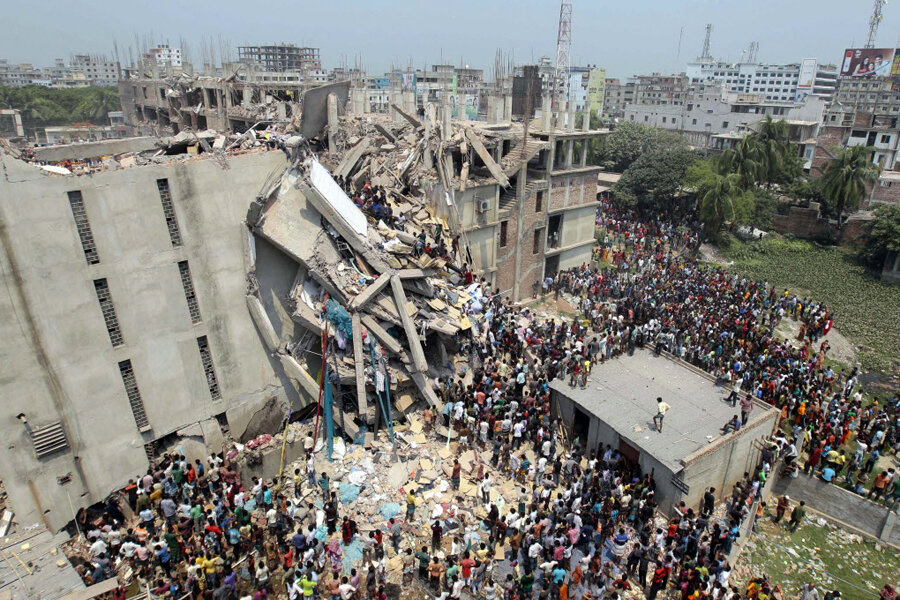Day after cracks were found, Bangladesh factory collapse leaves 125-plus dead
Loading...
| Savar, Bangladesh
Eleven-year-old Taslima asked her mother not to go to her job at a local factory this morning after workers there noticed large cracks inside the building.
But where would the money come from if she did not go to work? Taslima's mother asked her before heading off to work like normal.
This evening, Taslima is in tears, sitting by her mother’s body in a makeshift mortuary. Her mother was one of the more than 125 killed when the eight floor building collapsed on the outskirts of Bangladesh’s capital, Dhaka. Some 800 more were injured. As search-and-rescue efforts continue, those numbers are likely to rise, say witnesses, who report that hundreds of people may still be trapped in the rubble.
An inspection team visited Rana Plaza, where the factory building is located in the suburb of Savar, the day before the collapse and asked the owner to keep the building closed after they identified cracks in it. That instruction, however, was ignored.
The incident is not an aberration for Bangladesh. It comes on the heels of a series of factory disasters, the latest just five months ago, when a fire ripped through the Tazreen factory in Dhaka while workers were trapped inside: More than 100 died. The collapse revives concerns about the poor working conditions, code violations, and garment owner negligence that has racked the world's second-largest garment-exporting country, where firms produce clothing for high-profile brands including Gap, H&M, and Wal-Mart.
“This is an example of the most irresponsible and insensible work by the authority,” says Selim Newaj Bhuiyan, former deputy director of Fire Service and Civil Defense. Mr. Bhuiyan has attended to some of the deadliest factory fires and collapses in Dhaka. “When the building was warned, how could the authorities ask the workers to come to work?” he asks. Bhuiyan places the blame on building and factory authorities.
One worker at the factory, Sumi, described coming to work at 8:00 a.m., despite what she calls a subconscious fear in her mind.
When debris began falling from the ceiling of the fifth floor where she worked, it was already too late for her to escape. She was trapped inside along with hundreds of others as the floors collapsed one after another. Firefighters pulled her out five hours later. She was receiving treatment at a nearby hospital.
On the seventh floor, right after meeting with production managers and supervisors, Shariful Islam was returning to his work when suddenly he heard a loud noise.
“Immediately we fell several stories down faster than an elevator’s speed,” says Mr. Islam, a quality checker at New Wave Bottoms, one of the factories that rented the building (the others included New Wave Style and Phantom Apparels).
“I closed my eyes as the entire place was engulfed with dust. A stitching machine fell on my left leg,” says Islam, who later managed to escape the building with the help of two co-workers. “All I could see were dead bodies all around me.”
Flouting standards
At least 630 people have died in more than 30 incidents since 1990, according to the Bangladesh Institute of Labor Studies. Eight years ago, another factory collapse outside Dhaka killed about 70 workers. In most cases factory owners have been identified flouting safety standards, but very few of them are brought to court.
Former President of the Bangladesh Garment Manufacturers and Exporters Association (BGMEA) Abdus Salam Murshedy told The Christian Science Monitor that since the Tazreen fire last November officials are working to inspect and identify the many buildings not up to code.
It takes time, he says, to look into the licenses of all of Bangladesh's factories.
According to a fact-finding report of Bangladeshi human rights organization Odhikar, the Chief Inspector of Bangladesh’s Factories and Establishment renewed Tazreen’s safety inspection without even visiting the premises. A token sum of money was enough for the factory authorities to “get the application [for factory operations] approved on mobile phone,” according to Odhikar’s report.
“Only compensation [for the victims and their families] and mourning such incidents are not enough. There are many vulnerable factories that are not looked into,” says Babul Akhter, president of Bangladesh Garment and Industrial Workers’ Federation. Mr. Akhter urges international buyers to be more cautious while placing orders to the suppliers and ensure that the suppliers comply with the standards.
Bangladesh’s garment industry, the second largest garment exporter in the world, makes up 80 percent of country’s export revenue. The garment sector earned $19 billion from exports in the financial year that ended in June 2012.
“We will investigate this incident jointly with the government and make it public,” says the current president of the BGMEA, Atiqul Islam.








